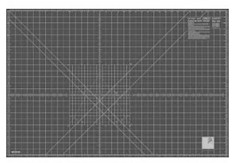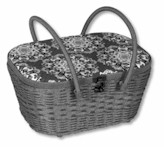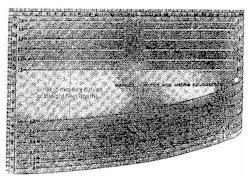|
|
 Needles Needles
Hand sewing needles guide the thread through fabric when you are hand sewing and are available in a variety of sizes and points. The most commonly used hand sewing needles are called "sharps." (see related articles: Hand Sewing Needles and How-To Choose a Sewing Needle
|
 |
 Pins and Pincushion Pins and Pincushion
A pin is a device used for fastening objects or material together. It is usually made of steel, and is formed by drawing out a thin wire, sharpening the tip, and adding a head.
A pincushion (or less commonly pin cushion) is a small cushion, typically 3-5 cm across, which is used in sewing to store pins with their heads protruding so as to take hold of them easily.
Pincushions are typically filled tightly, so as hold pins rigidly once placed.
The standard tomato pincushion (shown to the left) seems to have been around forever and is filled with sawdust and wool roving. The wool roving contains lanolin and prevents the pins from rusting.
The strawberry that is attached to pincushions is filled with fine sand or emery. The abrasive action of these fillers, remove dirt and rust, keeping the pin or needle sharp and smooth. |
|
 Needle Threader Needle Threader
A needle threader is a bent piece of thin wire attached to a small handle and is used to aid the user in getting the thread through the eye of a hand sewing or machine needles. The wire loop is passed through the eye of a needle, the thread is inserted through the wire loop and is then pulled back through the eye of the needle.
|
|
 Thimble Thimble
A thimble is a protective shield worn on the finger or thumb. Thimbles are most usually made from metal, leather, rubber, wood, glass or china. Early thimbles were sometimes made from bone, horn or ivory.
Originally thimbles were used solely for pushing a needle through fabric or leather as it was being sewn. However they have since gained many other uses. In the 1800s they were used to measure spirits (hence the phrase "just a thimbleful"). During the First World War silver thimbles were collected from "those who had nothing to give" by the British government and melted down to buy hospital equipment. In the 1930's and 40's red-topped thimbles were used for advertising. People who collect thimbles are known as digitabulists. |
|

 Skirt Marker Skirt Marker
A skirt marker is an easy-to-use tool for marking hems. Two types are available: the pin marker and the chalk marker. The pin marker is placed on the floor, while wearing the skirt, the skirt hem is placed between the adjustable metal while another person pin marks the hemline. The chalk model enables one person to mark a hem.
|

 Tape Measure Tape Measure
A tape measure or measuring tape is a ribbon of cloth, plastic, or metal with linear-measure markings, often in both imperial and metric units. Tape measures intended for use in tailoring or dressmaking are typically made of flexible cloth or plastic. Commonly used to take body measurements or for taking any measurements. Because it is flexible, it can measure non-straight items such as circles.

 Sewing Gauge Sewing Gauge
A sewing gauge is a 6" ruler with a sliding marker that adjusts to your desired measurement. It is handy in the marking of hems, tucks, pleats, or button/buttonhole spacing.

 Dressmaker's Gauge Dressmaker's Gauge
The dressmaker's gauge is used to measure different sized scallops, buttonholes, pleats, or tucks.
|
|
|
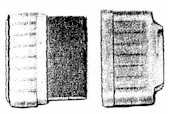
 Tailor Chalk Tailor Chalk
Tailor chalk is used to mark on fabric and then is easily brushed away. It is used for construction marking and fitting alterations.
|

 Pencil Chalk Pencil Chalk
Like any pencil, pencil chalk makes a thin, accurate line used to mark pleats and buttonholes. The brush end removes the chalk when finished.
|
|
Scissors are a tool used for cutting thin material which requires little force. Unlike a knife, scissors have two hinged blades. Most types of scissors are not particularly sharp; it is primarily the shearing between the two blades which cuts. Scissors can also be made to fit left-handed or right-handed. |

 Bent-Handle Shears - 6"-12" lengths - used for pattern cutting Bent-Handle Shears - 6"-12" lengths - used for pattern cutting
The off-set design of the handle allows the bottom blade to rest on the flat surface below the fabric without your hand lifting the fabric off the flat surface allowing the fabric to remaining flat and smooth.
|
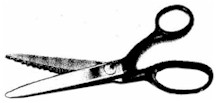
 Pinking Shears - 5 1/2"-10 1/2" lengths - used for finishing seams Pinking Shears - 5 1/2"-10 1/2" lengths - used for finishing seams
Pinking Shears have jagged blades that fit together to cut a saw-tooth type edge which produce a seam finish.
|

 Lingerie Shears - used to trim close to stitching and for cutting shear fabric Lingerie Shears - used to trim close to stitching and for cutting shear fabric
|

 Light Trimmers - 6"-7" lengths - used for small cutting jobs Light Trimmers - 6"-7" lengths - used for small cutting jobs
|

 Sewing Scissors - 5"-6" lengths Sewing Scissors - 5"-6" lengths
|

 Embroidery Scissors - used for needlework and small cutting jobs Embroidery Scissors - used for needlework and small cutting jobs
|

 Tailor Points - used for cutting heavy fabrics Tailor Points - used for cutting heavy fabrics
|
Electric Scissors |
Rotary cutters are round blades with a handle and protective cover for the blade used with rotary pads or mats and rotary rulers. |
|
 Rotary Cutter Rotary Cutter
Rotary cutters are used with a rotary ruler to make straight cuts and are available with different handles and protective devices to safely handle the sharp razor blade. This handy cutter is used extensively in quilting.
|
|
 Rotary Cutter Pad or Mat Rotary Cutter Pad or Mat
A rotary cutting pad or mat is is used as a flat surface to cut fabric with a rotary cutter and ruler. It is made of a self-healing material that prevents the blade from damaging the surface below.
Rotary rulers have 1" through 1/8" markings as well as 30, 45 and 60 degree angle markings. The small black dots make aligning the ruler easy and accurate.
|
|
|
| |
|
|
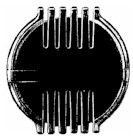
 Beeswax Beeswax
Beeswax is a tough wax formed
from a mixture of several compounds secreted by honeybees. When used
in sewing, the sewing thread is
drawn across the beeswax cake
before sewing, to strengthen the thread.
|

 Awl Awl
An awl is made up of a wooden
handle with a pointed, needle-shaped piece of steel protruding from it.
The handle is typically round or
cylindrical and fits in the palm of
the users hand. The awl is used in
sewing to punch holes into fabric,
vinyl, or leather for keyhole
buttonholes or eyelets.
|

 Seam Ripper Seam Ripper
A seam ripper is a small tool used for unpicking stitches. The most common form consists of a handle, shaft and head. The head is usually forked with one side of the fork flattening out and becoming a blade and the other side forming a small point. In some designs the blade side then tapers back to a point to allow easier insertion in tight stitching.
In use, the blade is inserted into the seam underneath the thread to be cut. The thread is allowed to slip down into the fork and the tool is then lifted upwards allowing the blade to cut through the thread. Once the seam has been undone in this way the loose ends can be removed and the seam re-sewn.

 Bodkin Bodkin
A bodkin is a tool shaped like a long, blunt needle. It is used like a needle to thread elastic, ribbon, or cording through a casing or large hole.

 Loop Turner Loop Turner
Used to turn bias tubing inside out, the loop turner is a long wire tool with a hook on the end. The loop turner is inserted into the tubing, the hook grasps the end of the fabric, and the fabric is turned/pulled over the wire.
|
|
Sewing Patterns
The dictionary definition of pattern is "anything cut or formed to serve as a guide to cutting or forming objects; as, a dressmaker's pattern." Commercial sewing patterns are developed so the home sewer can create a desired garment with no knowledge of pattern drafting. Commercial patterns come in an envelope with the tissue pattern pieces inside. On the outside of the envelope is a drawing/sketch of the finished garment. On the back of the pattern, you will find sizes available, suggested fabrics, notions needed, etc. |
|
|
 Sewing Basket or Container Sewing Basket or Container
A sewing basket or box or container is used to hold your sewing equipment such as needles, thread, scissors, etc. Sewing caddies and/or sewing furniture may be used for large quantities of supplies.
|




